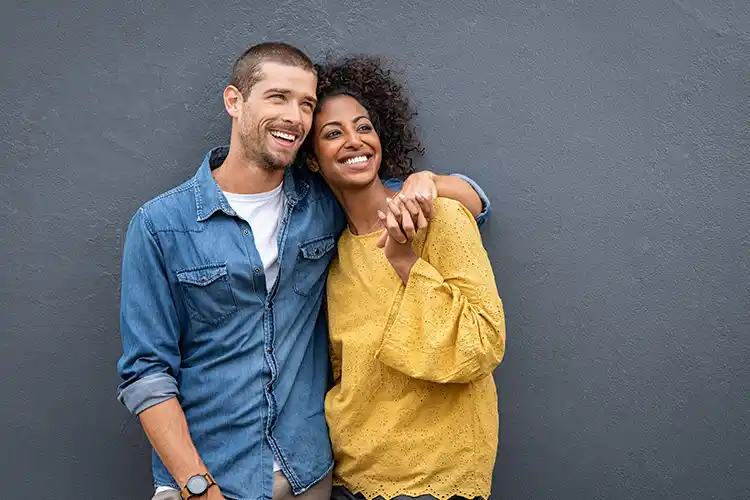
Hair Transplants and Partnerships – What Changes in the Relationship
We are always changing, externally and internally. But as we age, more than just our looks can change. Our relationships also shift, sometimes as a result of the physical transformations we undergo. This can introduce new dynamics of insecurity, shame, or tension.
For many people, hair loss isn’t just an aesthetic issue — it’s a profound emotional burden. The decision to undergo a hair transplant is therefore often more than a cosmetic procedure. It’s a turning point. But what does this change mean for your relationship with your partner?
Self-Image and the Effect on Intimacy
After a successful hair transplant, you can expect more than just your outward appearance to change. Self-confidence typically also increases – with noticeable consequences for your relationships. Those who feel attractive again are more open, courageous, and emotionally accessible.
Many report feeling less inhibited in intimate moments, accepting compliments again, and feeling desirable. This new charisma doesn’t go unnoticed by their partner either – and can foster closeness where previously there was insecurity.
Partners’ Expectations: Between Support and Restraint

A hair transplant is a personal step—but in a relationship, it always affects both partners. Some partners accompany the process with understanding, encouragement, and genuine interest. Others are more reserved, sometimes even skeptical.
It is not uncommon for such a drastic decision to prompt some difficult questions in a relationship, too. Many partners can find themselves asking:
- “Are you really doing this just for yourself?”
- “Will you change after this?”
- “Do you still find me attractive?”
Such thoughts are not uncommon—and deserve space. What’s crucial is that both sides communicate openly about what they hope to achieve (and what they don’t) with the change.
Addressing Jealousy, Admiration, and Insecurity
A newly boosted sense of self-confidence can also trigger tension. Those who visibly change after the procedure—and perhaps receive more compliments from others—sometimes elicit mixed feelings in their partners, such as admiration and pride, but also uncertainty or jealousy.
This is especially true if the relationship was previously characterised by insecurities or if appearance issues played a significant role. In these cases, it helps to reflect on the change together—not as a threat, but as an opportunity for new depth.
Communication is Key: How the Process Strengthens the Partnership
Like any personal change, a hair transplant requires space for exchange. Ideally, this dialogue begins before the procedure and continues throughout the healing phase. Here are so topics couples should discuss together before and during this journey:
- What are your expectations for the procedure?
- How can the partner actively support the patient – emotionally, organisationally, practically?
- What changes in everyday life or in self-image have you noticed after the procedure?
Openness builds trust – and can even deepen the bond. Many report feeling not only more attractive after the procedure, but also more connected.
Why a Hair Transplant Can Change More Than Just Your Appearance

Hair transplantation isn’t simply an aesthetic procedure. It affects one’s self-image—and thus often also the way one wants to be loved. Those who feel comfortable in their bodies again approach their partners more confidently, communicate more clearly—and are ready for real intimacy.
While alternative methods such as tinctures or nutritional supplements often provide only short-term or insufficient relief, transplantation offers a permanent solution with real emotional benefits. Patients report not only increased self-confidence but also a new sense of togetherness in their relationships.
Conclusion: A Positive Change
A hair transplant not only changes the reflection in the mirror, but often also the relationship with oneself – and with one’s partner. If both parties communicate openly, the procedure can open up a new chapter of intimacy.
Because those who feel beautiful again can experience love anew – fearlessly, shamelessly, and with a full head of hair. Find out more about how a hair transplant in Turkey can help you start your own transformation.
FAQs
How long after a hair transplant will the emotional and relational effects become noticeable?
The emotional boost usually begins once the initial healing phase is over and the new hair starts to grow — typically three to six months post-surgery. Many people feel a sense of relief and renewed confidence as they see visible results, which then positively influences their relationship dynamics.
Can a hair transplant put strain on a relationship instead of strengthening it?
Yes, in some cases it can. If the decision is not openly discussed, a partner may feel excluded or question the motivation behind it. Misunderstandings, jealousy, or fear of change may surface. Honest communication and reassurance are essential to avoid unnecessary strain.
How can someone involve their partner in the process without making them feel pressured?
Inviting your partner to consultations, sharing information about the procedure, and asking for their perspective can make them feel included. However, it’s important to emphasise that the final decision is personal, and the partner’s role is one of support rather than control.
What role does patience play in adjusting to the changes after a transplant?
Patience is crucial for both partners. The physical results take months to fully appear, and the psychological adjustments can also take time. Partners should be prepared for gradual changes rather than expecting an instant transformation in appearance or confidence.
How might intimacy specifically be affected in the early recovery stage?
Immediately after surgery, there may be restrictions on physical closeness to avoid damaging the transplanted area. This temporary limitation can be frustrating but usually only lasts a few weeks. Once healed, increased confidence often leads to a richer intimate connection.
Can therapy or counselling help couples navigating these changes?
Absolutely. Couples counselling or even individual therapy can provide a safe space to address insecurities, jealousy, or shifting expectations. Professional guidance often helps both partners process the change constructively.


